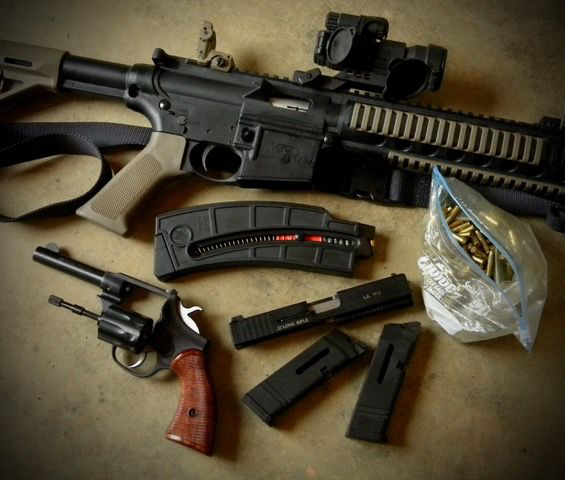
The last couple of columns we’ve been talking about dry fire practice, which is affordable and provides excellent returns on your time. Ammo is still hard to get, and expensive. An affordable alternative for live fire is .22 long rifle – especially while we’re seeing ammo in larger calibers going for near one dollar per round.
Dry practice is great for improving existing skills. However, live fire practice is still necessary for an introduction to the basics of marksmanship – Aim, Hold, Press and Follow-through. One has to “see” some results, where the bullet strikes, in order to understand the need for these fundamentals. You can practice manipulations dry – loading, unloading, reloading and clearing stoppages. But in order to get the full effect and sequence, it’s a good idea to perform these actions with live fire. Fire, reload or clear the stoppage, then shift gears to fire another accurate shot.
There are two options for .22 training. You can get conversion kits to transition your normal shooter into a .22 trainer. Or, there are dedicated .22 platforms you can purchase. .22 conversion kits for the AR platform have been around for many years. They come with a new bolt group, magazines and sometimes a different charging handle to use with the kit. Since the AR isn’t really designed to shoot .22lr you may see some accuracy loss. It’s also necessary to keep the rifle and parts clean. It’s mandatory to make sure the gas tube doesn’t get clogged up with lead. (I’ve seen this occur several times.)
Since there’s not any high-pressure gas blasting through the tube, which normally keeps the tube clean, you’ll need to inspect the port in the barrel and gas tube to make sure there’s no blockage before switching back to the center fire components. There are also kits for converting your pistol over to .22 rimfire. These come with a new slide and barrel assembly, and of course magazines to use with the kit. The value of using conversion kits is that you’re using the same frame or platform as usual.
Today there are plenty of dedicated .22lr firearms to use. These are well made, and often exact replicas of your center fire weapon. The S&W 15-22 AR is a favorite of mine. It operates basically the same as my center fire AR, and is fairly easy to set up with any accessories to match your standard configuration. A lot of companies are offering their standard weapons in .22lr now. Even Glock recognized the market for this and brought the Glock 44 to market, which is a .22lr about the same size as their popular G19.
Keep in mind that .22s are sometimes finicky. You may have to do a little testing to discover what brand/type ammo your .22 likes to eat. This is critical for function, and accuracy. Once you start shooting, you’ll discover a big difference in accuracy. They’re also dirty, so make sure to clean after every session.
Practice is necessary for learning any skill. Dry practice is great. It’s an affordable way to get in the repetitions to improve. But I’ll admit, it ain’t as fun as live fire practice. Due to ammo supplies and cost, the .22lr might be just the ticket to maintain and confirm your skills, introduce a new shooter to firearms or, every so often you just need to hit the range for some fun plinkin’.
P.S. Thanks to all you veterans!
Tiger McKee is director of Shootrite Firearms Academy. He is the author of The Book of Two Guns, AR-15 Skills and Drills, has a regular column in American Handgunner and makes some cool knives and custom revolvers. Visit Shootrite’s Facebook page for other details.